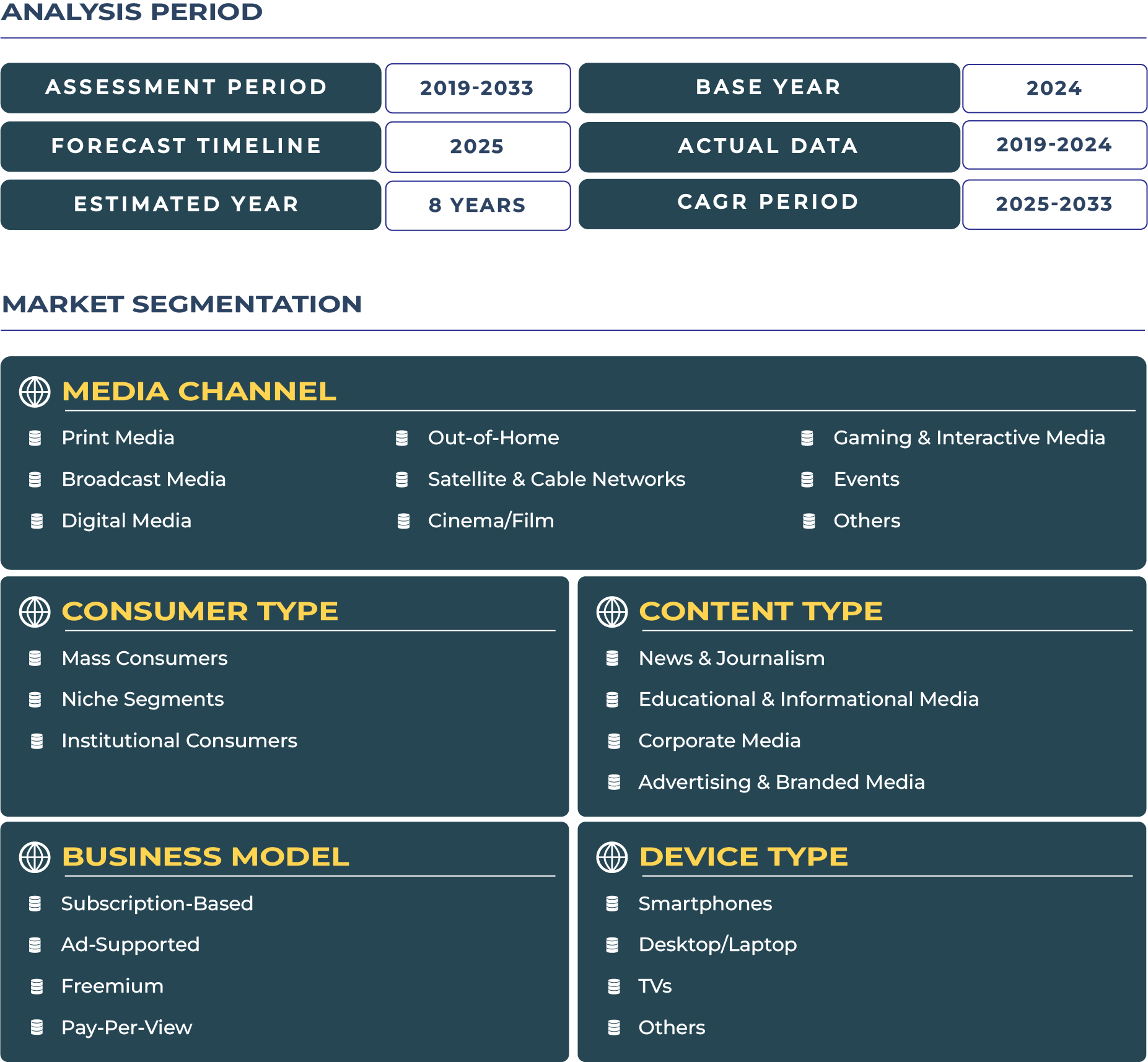Zimbabwe Media Market Outlook
The Zimbabwe media market is undergoing a period of dynamic evolution, defined by an interplay of digital innovation, shifting consumer preferences, and the emergence of homegrown platforms. Valued at approximately US$ XXX million in 2024, the Zimbabwe media industry is projected to reach US$ XX.25 billion by 2033, registering a compound annual growth rate (CAGR) of XX.2% from 2025 to 2033, according to DataCube Research. Despite macroeconomic challenges and regulatory fluctuations, the sector continues to thrive on innovation and the resilience of local creators and broadcasters
The Zimbabwe media sector still maintains a significant traditional footprint, especially through radio and print, but there has been a strong pivot toward digital content in urban areas such as Harare, Bulawayo, and Gweru. The rise in mobile phone usage, social media penetration, and increasing digital literacy has redefined how Zimbabweans consume content. The Zimbabwe media ecosystem is expanding as public and private broadcasters, OTT players, and independent creators capitalize on mobile-first behaviors and localized content strategies
Digital Infrastructure, Content Innovation & Policy Push Fuel Market Expansion
One of the key drivers behind the Zimbabwe media market’s growth is the increasing accessibility of digital infrastructure. Internet penetration in Zimbabwe stood at 64.9% as of Q4 2023, according to the Postal and Telecommunications Regulatory Authority of Zimbabwe (POTRAZ). This rise in connectivity, coupled with over 15 million active mobile subscriptions, has led to a spike in online content consumption across platforms such as YouTube, Facebook, and TikTok
The Zimbabwean government has made strategic moves to support media digitization. The Zimbabwe Digital Broadcasting Migration Project, launched in 2023, has fast-tracked the switchover from analogue to digital TV, opening up bandwidth for new players and promoting regional content distribution. The National Development Strategy 1 (NDS1) further emphasizes media as a pillar of socio-economic development, encouraging private-sector participation in content creation and media entrepreneurship. These policy measures are not only expanding the audience base but also boosting local narratives across digital spaces
Ad Spend and Content Exports Show Promise
Economically, the Zimbabwe media industry is gaining strength despite a challenging macro backdrop. With a GDP per capita of around US$ 1,450 in 2024 and signs of urban income recovery, the market is gradually seeing an uptick in consumer spending on media products and subscriptions. Advertising expenditure, while still modest, reached 0.45% of GDP in 2024, and digital advertising now accounts for nearly 34% of the total media spend—a notable increase from just 18% in 2020
On the export front, Zimbabwean documentaries, music videos, and short films are making their mark on platforms such as Africa Magic, Netflix Africa, and YouTube Originals. The award-winning 2023 short film Ngoda, directed by Denzel Bhebhe, gained global attention after being selected at the Durban International Film Festival. This growing visibility is helping local creatives tap into international markets and collaborations, signaling Zimbabwe’s soft power potential in content exports
Young, Digital, and Language-Conscious: The Pulse of Zimbabwean Media Consumers
The heart of the Zimbabwe media ecosystem lies in its young, tech-savvy population. With over 60% of Zimbabweans under the age of 35, media consumption habits are evolving rapidly. Consumers are increasingly mobile-first, spending an average of 5.4 hours per day on digital content across streaming services, social platforms, and news portals. OTT subscription penetration remains relatively low at 11%, but ad-supported and freemium platforms have much higher reach, especially among lower and middle-income urban consumers
When examining consumer behavior in Zimbabwe, it's evident that audiences prioritize localized, relatable, and value-driven content. Urban users are willing to pay for premium experiences on platforms like DStv’s Showmax or Zimpapers’ ZTN Prime, while rural and township consumers tend to favor free-to-air TV, radio, or mobile-optimized platforms. Monthly average spending on media services ranges from US$ 1.8 to 5.2 depending on region and content type. Keywords like medtech adoption in Zimbabwe are also gaining traction in infotainment and educational content as the public becomes more engaged in healthcare awareness through digital channels
Key Media Players, Local Content Channels, and Strategy Highlights
In the Zimbabwe media sector, both local and regional brands are carving out strong identities. Popular broadcasters like Zimbabwe Broadcasting Corporation (ZBC), 3Ktv (launched in 2022), and ZTN Prime continue to dominate the terrestrial and satellite media space. International platforms such as DStv, Netflix, and YouTube serve as premium content providers for wealthier households. In March 2024, ZTN Prime announced a partnership with Econet Wireless to launch zero-rated content access for its mobile subscribers—a strategy aimed at increasing youth engagement and driving mobile content traffic
Zimbabwe’s vibrant language landscape—featuring Shona, Ndebele, and English—has prompted platforms to diversify their linguistic offerings. For instance, the rising YouTube channel “Comic Pastor TV” gained over 500,000 subscribers by late 2023 through vernacular comedy sketches, while the mobile platform Sasai (by Cassava Smartech) introduced Shona and Ndebele language podcasting support in January 2024 to encourage localized storytelling
Strategically, media companies are focusing on hybrid distribution models—merging radio, podcasting, live TV, and social media streaming. Content monetization strategies include influencer-based campaigns, mobile advertising bundles, live shows, and branded entertainment. Cross-border content collaborations, like the 2024 Zimbabwe–South Africa digital series Urban Crossroads, are helping amplify regional appeal and boost viewership beyond local borders.
Author: Joseph Gomes Y (Head – Media and Entertainment)
*Research Methodology: This report is based on DataCube’s proprietary 3-stage forecasting model, combining primary research, secondary data triangulation, and expert validation. [Learn more]







